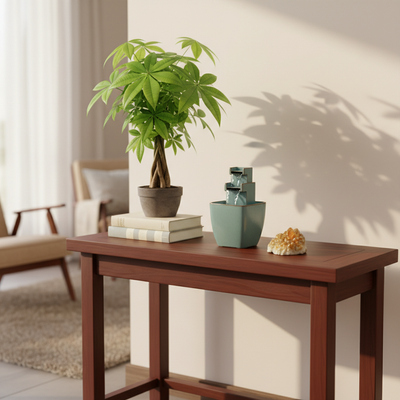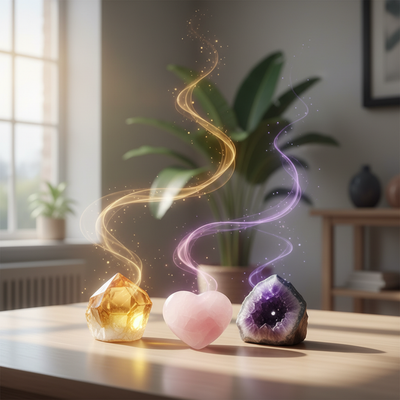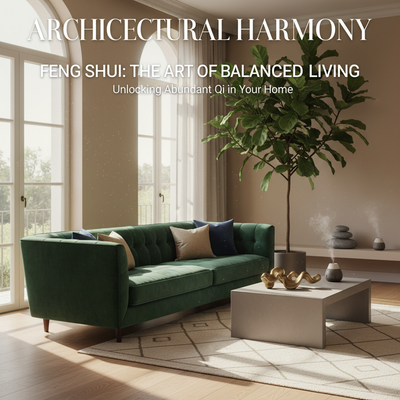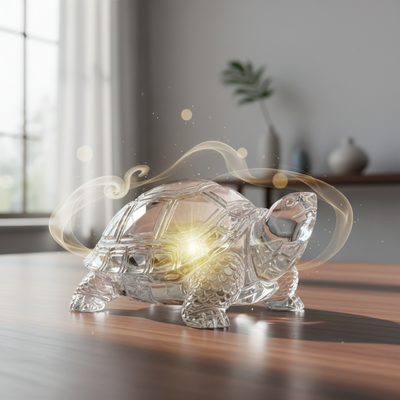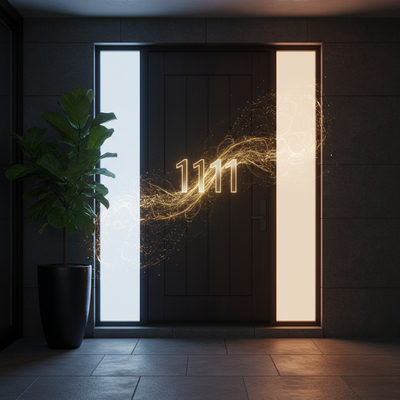Is a Peace Lily Good?

Yes, a peace lily is generally considered excellent for bedroom feng shui. For modern practitioners, it is one of the most highly recommended plants for a space dedicated to rest and rejuvenation. Its unique combination of energetic and physical properties works to create a sanctuary-like atmosphere.
Before we dive into the specific placement and care, here are the core reasons why the peace lily is a powerful feng shui ally for your bedroom:
- Air Purification: It physically cleanses the air of harmful toxins, which in feng shui translates to clearing stagnant or negative energy from your personal space.
- Calming Yin Energy: Its soft, drooping leaves embody the restorative, gentle nature of Yin energy, which is essential for promoting deep sleep and relaxation.
- Symbolism of Harmony: The iconic white flower is a universal symbol of peace, purity, and truce, helping to soothe mental chatter and promote emotional tranquility.
This guide will explore exactly how to place and care for your peace lily to maximize these benefits and avoid common pitfalls, turning your bedroom into a true haven of positive energy.
The Feng Shui Essence
To truly harness the power of a peace lily, it's vital to understand the "why" behind its effectiveness. In feng shui, a plant's physical characteristics—its shape, color, and biological function—are direct expressions of its energetic qualities, or Chi. The peace lily is a perfect example of how form and function create a potent energetic tool.
A Natural Air Purifier
The peace lily is not just a decorative object; it is an active participant in creating a healthy environment. This is not just a metaphysical belief but a scientific fact. Its inclusion in the famous NASA Clean Air Study confirmed its ability to remove common household toxins from the air, including benzene, formaldehyde, trichloroethylene, and ammonia.
From a feng shui perspective, this physical cleansing is directly linked to energetic cleansing. These invisible toxins contribute to what we call stagnant energy or Sha Chi (negative Chi). By filtering the air you breathe while you sleep, the peace lily is simultaneously filtering the energy of your most personal space. It helps clear away the energetic residue of stress, arguments, and daily anxieties, creating a fresh canvas for rest and renewal each night.
The Power of Yin
Feng shui operates on the principle of balancing two opposing yet complementary forces: Yin and Yang. Yang is active, bright, and upward-moving energy, while Yin is passive, dark, receptive, and restorative.
The bedroom is fundamentally a Yin space. Its primary purpose is rest, healing, and intimacy—all Yin activities. The peace lily, with its lush, broad, and gently arching leaves, is a quintessential Yin plant. Its soft appearance and downward-curving foliage promote a sense of calm and release. This stands in stark contrast to "Yang" plants with sharp, spiky, or upward-pointing leaves (like a snake plant), which can introduce an aggressive or overly active energy that may disrupt sleep. The peace lily's gentle presence soothes the nervous system and encourages the body and mind to let go.
Symbolism in Form
Every part of the peace lily contributes to its overall energetic signature. Its unique structure offers a beautiful balance of different elemental energies, making it a well-rounded feng shui tool for the bedroom.
The white, hood-like flower, which is actually a modified leaf called a spathe, is its most defining feature. This white spathe connects to the Metal element in feng shui. The Metal element governs clarity, precision, purity, and integrity. Placing this energy in the bedroom helps to cut through mental clutter and emotional confusion, fostering a sense of peace and clear-headedness. The upright stalk of the flower also represents gentle, positive growth and a connection to higher spiritual aspirations, all while being cradled by the nurturing Yin leaves.
| Plant Feature | Feng Shui Element/Energy | Meaning in the Bedroom |
|---|---|---|
| Lush, Green Leaves | Wood Element, Yin Energy | Nurturing, calming, promotes rest and healing. |
| White Spathe/Flower | Metal Element | Purity, peace, clarity of mind, reduces mental clutter. |
| Air-Purifying Roots | Earth Element | Grounding, stability, filtering negative Chi. |
Ultimate Placement Guide
Now that we understand why the peace lily is so beneficial, let's move to the most critical part: where to place it. In feng shui, placement is everything. Putting the right object in the right place can amplify its positive effects and target specific areas of your life you wish to improve. To do this, we use a tool called the Bagua map.
The Bedroom Bagua
The Bagua is the energy map of your space. Imagine a three-by-three grid that you overlay on your bedroom floor plan. To orient this map, you stand at the threshold of your bedroom door looking in. The row of three squares closest to you corresponds to the Knowledge, Career, and Helpful People areas. The far row corresponds to Wealth, Fame, and Relationships.
Each of these nine areas, or "guas," relates to a specific life aspiration. By placing a peace lily in a particular gua, you use its energy to activate and support that area of your life.
The Placement Matrix
We've developed this Peace Lily Placement Matrix as a simple yet powerful tool to help you make the most intentional choice for your bedroom. Find the aspiration you want to focus on and place your plant in the corresponding corner.
| Bagua Area (Location from Door) | Life Aspiration | Why Place a Peace Lily Here | Best For... |
|---|---|---|---|
| Far Left Corner | Wealth & Prosperity | The peace lily's Wood energy nurtures this area, promoting a sense of abundance and gratitude. Its purity helps clear money blocks. | Individuals wanting to cultivate an "abundance mindset" and feel more prosperous in life. |
| Far Right Corner | Love & Relationships | The plant's calming Yin energy can soothe relationship tension. Its symbolism of peace helps foster harmony with a partner. | Couples seeking more peace and harmony, or singles wanting to attract a calm, supportive relationship. |
| Center Left | Family & New Beginnings | Its nurturing energy can smooth family dynamics. The Wood element here supports growth and fresh starts. | Those looking to heal family rifts or bring gentle, supportive energy to new projects. |
| Center Right | Creativity & Children | The Metal element of the white flower brings clarity and precision to creative projects. It provides a peaceful creative space. | Artists, writers, or anyone feeling creatively stuck. Also good for fostering peace in a child's bedroom. |
| Near Left Corner | Knowledge & Self-Cultivation | The calming energy promotes a clear mind, ideal for study and meditation. It supports personal and spiritual growth. | Students, or anyone focused on self-improvement, learning, or developing a meditation practice. |
A Real-World Case Study
Theory and charts are essential, but seeing the real-world impact of these principles is what truly demonstrates their power. At THE QI FLOW, our work is centered on facilitating tangible transformations for our clients by shifting the energy of their environment. The story of one of our clients, nan, is a perfect illustration of how a simple peace lily can be a catalyst for profound change.
The Challenge for nan
When nan first contacted THE QI FLOW team, she was at a point of deep frustration. A successful professional in a demanding field, she found herself unable to get a full night's sleep. She would wake up multiple times, her mind racing with work-related anxieties. This exhaustion bled into her waking life, leaving her feeling "stuck" and uninspired in her career, unable to break through on a critical project. nan described the feeling in her bedroom as heavy and stagnant, even though she kept it meticulously clean and tidy. The space lacked vitality, and as a result, so did she. This is a common challenge we see: a space that is clean but energetically lifeless.
The QI FLOW Solution
Our team conducted a full assessment of nan's apartment, focusing on her bedroom. It was immediately apparent that the room was dominated by heavy, dark furniture and lacked a vibrant, living element. There was no "life force" or Chi to circulate and uplift the space.
Our primary and most immediate recommendation was the introduction of a healthy, vibrant peace lily. This was not just about adding a plant; it was a strategic energetic intervention. Based on nan's specific goals—to clear her mind and find a breakthrough in her professional development—we advised her to place the peace lily in the Knowledge & Self-Cultivation area of her bedroom (the near-left corner from the door). This placement directly supports mental clarity, focus, and learning. We also guided her in choosing a specific pot: a heavy, ceramic planter in a deep terracotta color. This Earth element pot would ground the plant's energy, providing a stable foundation for the mental and spiritual growth she was seeking.
The Resulting Shift
The results were not instantaneous, but they were significant. Within two weeks, nan reported that she was beginning to sleep through the night more consistently. She described a feeling of her mind being "quieter" when she went to bed. About a month after introducing the plant, she had a major breakthrough at work, solving a problem that had been plaguing her project for months. She attributed this to a newfound sense of clarity and focus.

Most importantly, nan said her bedroom finally felt like a sanctuary. It felt lighter, more welcoming, and more alive. The story of nan highlights a core feng shui principle: the peace lily was not a magic wand. It was, however, a powerful catalyst. By shifting the energy of her environment, it created a supportive container that allowed nan's own efforts to flourish.
Synergizing Your Peace Lily
Placing your peace lily in the right Bagua area is the first and most important step. However, to truly elevate its effect and function like a seasoned practitioner, you must consider how the plant interacts with its immediate surroundings. By creating a harmonious synergy with other elements, you can amplify its positive Chi.
Choosing the Right Pot
The pot is not just a container; it is the foundation of your plant's energy. Flimsy plastic pots feel temporary and unstable, which is not the energy you want in a bedroom.
- Material: We strongly recommend pots made of earthenware, ceramic, or terracotta. These materials come from the earth and represent the Earth element. This provides a grounding, stabilizing energy that supports the plant's Wood element, creating a beautiful cycle of support.
- Color: The color of the pot can be used to fine-tune the energy.
- Blue or Black: These colors represent the Water element. In the five-element cycle, Water nourishes Wood. Using a blue or black pot is like giving your plant an extra energetic boost, amplifying its properties of growth and healing.
- Earthy Tones: Brown, beige, or terracotta pots enhance the grounding Earth element, perfect for promoting stability and security. This is an excellent choice for a relationship or family corner.
- White or Metallics: A white, silver, or gold pot resonates with the Metal element of the peace lily's flower. This synergy amplifies the energies of clarity, purity, and precision, making it ideal for the Knowledge or Creativity areas.
Creating Elemental Harmony
Think about what you place your peace lily on or near. This creates powerful energetic pairings.
- Pairing with Wood: Place your peace lily on a wooden nightstand, a wooden dresser, or near a wooden headboard. This doubles down on the nurturing, healing energy of the Wood element. This is an especially potent combination for the Wealth & Prosperity area (far left) or the Family & New Beginnings area (center left), as both are governed by the Wood element.
- Pairing with Water: Water nourishes Wood. While a large water feature is generally not recommended for the bedroom, a very small, silent tabletop fountain or even a beautiful glass of fresh water placed near the peace lily can create a nourishing energetic circuit. Use this with caution, ensuring any sound is soothing and not disruptive to sleep.
- Pairing with Light: While peace lilies are famously low-light tolerant, they are not "no-light" plants. From a feng shui perspective, light is a form of Fire energy, which activates Chi. Position your plant where it can receive gentle, indirect morning light. This will not only help it thrive physically but will also activate its positive energy, allowing it to radiate throughout the room.
Essential Peace Lily Care
In feng shui, the health of your plant is paramount. A vibrant, thriving plant radiates vibrant, life-affirming Chi. A sickly, neglected, or dying plant does the opposite: it creates and radiates stagnant, draining energy (Sha Chi). Caring for your peace lily is not a chore; it is an essential part of maintaining good feng shui in your bedroom.
Your plant's condition is a direct reflection of the energy it is contributing to your space. Following these simple care guidelines will ensure your peace lily remains a beautiful and potent source of positive energy.
Your Care Checklist
- Light: Provide bright, indirect light. A spot near an east-facing window is often perfect. Keep it out of direct, harsh sunlight, which will scorch its leaves and create stressed energy.
- Water: Keep the soil consistently moist but never soggy. A good rule of thumb is to water thoroughly when the top inch of soil feels dry to the touch. Peace lilies are very communicative; they will visibly droop when thirsty, but they perk up quickly once watered. This "bounce back" is a beautiful display of resilient energy.
- Humidity: As tropical plants, peace lilies love humidity. If your home is dry, especially in winter, mist the leaves with a spray bottle every few days. This simple act is a way of nurturing your plant and, by extension, the energy of your room.
- Pruning: This is a crucial feng shui practice. As soon as you see a leaf turning yellow or brown, trim it off at the base with clean scissors. Removing dead or dying parts of the plant is equivalent to clearing stagnant energy and making space for new, healthy growth.
- Dusting: Leaves covered in dust cannot breathe or purify the air effectively. In feng shui, dust represents accumulated, stagnant Chi. Once a month, gently wipe down each leaf with a damp cloth. This not only helps your plant thrive but also keeps the energy in your room fresh and clear.
Potential Downsides
While the peace lily is one of the best feng shui plants for the bedroom, no solution is one-size-fits-all. Providing a balanced perspective is key to building trust and ensuring you make the best decision for your specific circumstances. It's important to be aware of a few potential concerns and exceptions.
A Note on Pets
This is a critical safety consideration. The peace lily (Spathiphyllum) contains calcium oxalate crystals and is toxic to both cats and dogs if ingested. It can cause significant irritation and inflammation of the mouth, drooling, vomiting, and difficulty swallowing. While usually not fatal, it is very unpleasant for your pet. If you have curious pets who tend to chew on plants, you must either place the peace lily on a high shelf or dresser completely out of their reach or opt for a different, pet-safe plant like a Prayer Plant or Calathea. Responsible feng shui is always safe feng shui.
Debunking the Oxygen Myth
You may have heard an old myth that having plants in the bedroom is unhealthy because they release carbon dioxide (CO2) at night through respiration. Some worried this would "steal" your oxygen while you sleep. We need to state this clearly: this is a complete myth that has been thoroughly debunked. The amount of CO2 released by a single plant (or even several plants) is infinitesimally small and has absolutely no negative impact on the air quality or human health. A sleeping pet or partner in the same room produces vastly more CO2 than any houseplant. In fact, the air-purifying benefits of the peace lily during the day far outweigh the negligible CO2 it releases at night.
Is Your Bedroom Too Yin?
Balance is the goal. While most modern bedrooms can benefit from more calming Yin energy, it is possible, in rare cases, for a room to be too Yin. A bedroom that is in a basement, has very small or no windows, is perpetually dark and cold, and feels lethargic might already have an excess of Yin energy. In such a specific case, adding another strong Yin element like a peace lily might contribute to a feeling of stagnation or low energy. For a room like this, you might instead consider a plant with more upright, "Yang" energy to introduce a bit of vitality, or focus on adding more light (Fire element) to balance the space.
Conclusion
The peace lily is far more than just a beautiful houseplant. It is a powerful, living ally in your quest to create a bedroom that serves as a true sanctuary for rest, healing, and rejuvenation. Its ability to physically purify the air, its embodiment of calming Yin energy, and its potent symbolism of peace and clarity make it an unparalleled choice for this most sacred space in your home.
We have explored the deep energetic roots of why it works and provided a clear, actionable map for its placement. By using the Bagua to target your specific intentions—whether for love, abundance, or self-growth—you transform your plant from a simple decoration into a tool for personal transformation.
Remember that a healthy plant radiates healthy Chi. By tending to its needs for light, water, and care, you are actively participating in the cultivation of positive energy. Embrace the serene, supportive presence of a peace lily in bedroom feng shui, and you will be taking a simple but profound step toward nurturing your sleep, your spirit, and your overall well-being.
